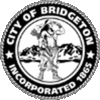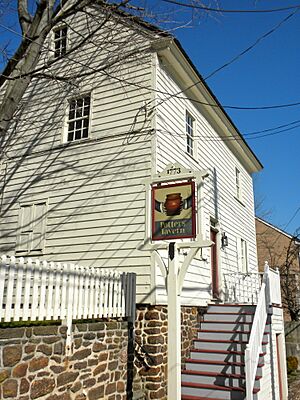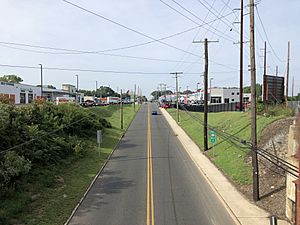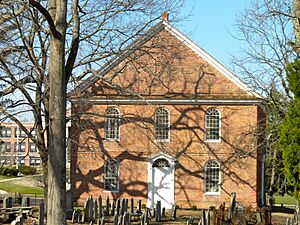Bridgeton, New Jersey facts for kids
Quick facts for kids
Bridgeton, New Jersey
|
|||
|---|---|---|---|
|
City
|
|||
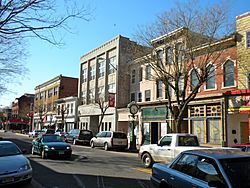
Downtown Bridgeton, March 2010
|
|||
|
|||

Location of Bridgeton in Cumberland County highlighted in red (left). Inset map: Location of Cumberland County in New Jersey highlighted in orange (right).
|
|||
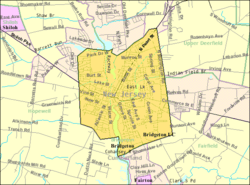
Census Bureau map of Bridgeton, New Jersey
|
|||
| Country | |||
| State | |||
| County | Cumberland | ||
| Incorporated | March 1, 1865 | ||
| Named for | Bridge on Cohansey River | ||
| Government | |||
| • Type | Faulkner Act (mayor–council) | ||
| • Body | City Council | ||
| Area | |||
| • Total | 6.49 sq mi (16.82 km2) | ||
| • Land | 6.23 sq mi (16.13 km2) | ||
| • Water | 0.27 sq mi (0.69 km2) 4.10% | ||
| Area rank | 249th of 565 in state 13th of 14 in county |
||
| Elevation | 39 ft (12 m) | ||
| Population
(2020)
|
|||
| • Total | 27,263 | ||
| • Estimate
(2023)
|
26,763 | ||
| • Rank | 93rd of 565 in state 3rd of 14 in county |
||
| • Density | 4,377.5/sq mi (1,690.2/km2) | ||
| • Density rank | 142nd of 565 in state 1st of 14 in county |
||
| Time zone | UTC−05:00 (Eastern (EST)) | ||
| • Summer (DST) | UTC−04:00 (Eastern (EDT)) | ||
| ZIP Code |
08302
|
||
| Area code(s) | 856 | ||
| FIPS code | 3401107600 | ||
| GNIS feature ID | 0885169 | ||
Bridgeton is a city in Cumberland County, New Jersey. It is the main town of Cumberland County. The city is located on the Cohansey River, close to Delaware Bay. It is part of the South Jersey region.
In 2020, Bridgeton had a population of 27,263 people. This was the highest number of people ever recorded in the city. Bridgeton and Vineland are the two main cities in the Vineland-Bridgeton area. This area includes all of Cumberland County. It is also part of the larger Philadelphia metro area.
Contents
History of Bridgeton
For thousands of years, Native American groups lived near the rivers and the bay. When Europeans arrived, the Lenape Native Americans lived here. They hunted, fished, and grew crops depending on the season. Today, the Nanticoke Lenni-Lenape Indians have a cultural center in Bridgeton. It serves about 12,000 people in the area.
The first European settlement in Bridgeton was in 1686. Richard Hancock built a sawmill here. Later, in 1814, settlers started an iron-works. Bridgeton became a township in 1845. Then, on March 1, 1865, it officially became a city. The city got its name from a bridge over the Cohansey River. People say "Bridgeton" comes from "bridge town."
After the American Civil War, Bridgeton grew a lot. It became a very successful town in New Jersey. This was because of its factories and farms. It was also a center for education. Bridgeton had glass factories, sewing factories, and metal works. The Ferracute Machine Works was a famous factory here. It was started by Oberlin Smith, a well-known inventor.
Historic Buildings and Areas
The Bridgeton Historic District covers a large part of the city. It has over 2,000 historic buildings. These buildings show different styles from the 1700s to the 1920s. The district was added to the National Register of Historic Places in 1982. It is the biggest historic district in New Jersey.
Many buildings in the district are large Victorian homes. There are also older buildings from the 1700s. One example is Potter's Tavern, built around 1750. It was home to The Plain Dealer, New Jersey's first newspaper. Another old building is Brearley (Masonic) Lodge, started in 1795. The "Nail House" from the early 1800s was important for Bridgeton's industry. The first Cumberland National Bank building (1816) is now part of the Bridgeton Library. The David Sheppard House (1791) is now the Cousteau Coastal Center of Rutgers University.
Bridgeton is located on the Cohansey River. The city's name comes from the first movable bridge built in 1716. This bridge made it easier to travel across the river.
Parks and Recreation
Bridgeton has many large city parks. The biggest one is Bridgeton City Park. It has pine forests, wetlands, and lakes. This park used to be owned by the Cumberland Nail & Iron Works. The city bought it in 1902 to keep it as a park. It includes three main lakes: Mary Elmer Lake, Sunset Lake, and East Lake. Bridgeton Park is about 1,500 acres (6.1 km2) in size.
The park is also home to the Cohanzick Zoo. This is New Jersey's oldest zoo, and it's free to visit!
Modern Bridgeton
In the 1980s, Bridgeton lost many factory jobs. But new jobs in farming have brought many immigrant workers. These workers mostly come from Mexico and Guatemala. Many residents and their children speak Zapoteco, an indigenous language, along with Spanish.
Downtown Bridgeton is becoming a lively place. It has an art gallery, second-hand stores, and a makerspace called STEAMWorks. STEAMWorks offers special equipment and workshops to the public. Bridgeton Main Street has also named the downtown area a "Culinary Arts district." This means they are focusing on food-related businesses.
Rutgers University opened the Cousteau Coastal Center in 2008. It is in the historic David Sheppard House. Here, scientists do research on the environment. They also create learning programs for students of all ages.
Bridgeton is also home to the Rutgers Food Innovation Center. This center helps new food companies develop and test their products.
Geography
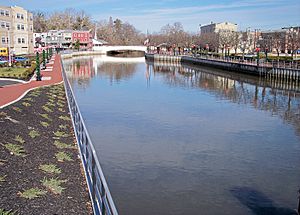
Bridgeton is about an hour's drive from Philadelphia. It is also about 50 minutes from Wilmington, Delaware. You can reach Atlantic City and Cape May in about an hour too. Bridgeton has three main areas: Northside, Southside, and Hillside.
The city covers about 6.49 square miles (16.82 km2). Most of this is land, with a small part being water. Bridgeton shares borders with Fairfield Township, Hopewell Township, and Upper Deerfield Township.
Climate
Bridgeton has hot, humid summers. Winters are usually mild to cool. This type of weather is called a humid subtropical climate.
Population and People
| Historical population | |||
|---|---|---|---|
| Census | Pop. | %± | |
| 1870 | 6,830 | — | |
| 1880 | 8,722 | 27.7% | |
| 1890 | 11,424 | 31.0% | |
| 1900 | 13,913 | 21.8% | |
| 1910 | 14,209 | 2.1% | |
| 1920 | 14,323 | 0.8% | |
| 1930 | 15,699 | 9.6% | |
| 1940 | 15,992 | 1.9% | |
| 1950 | 18,378 | 14.9% | |
| 1960 | 20,966 | 14.1% | |
| 1970 | 20,435 | −2.5% | |
| 1980 | 18,795 | −8.0% | |
| 1990 | 18,942 | 0.8% | |
| 2000 | 22,771 | 20.2% | |
| 2010 | 25,349 | 11.3% | |
| 2020 | 27,263 | 7.6% | |
| 2023 (est.) | 26,763 | 5.6% | |
| Population sources: 1870–2000 1870–1920 1870 1880–1890 1890–1910 1870–1930 1940–2000 2010 2020 |
|||
Bridgeton is a diverse city. Many people from different backgrounds live here. In 2015, some residents were living in poverty. The city has many immigrants from southern Mexico. They speak languages like Zapotec, Nahuatl, and Mixtec.
In 2010, Bridgeton had 25,349 people. About 43.6% of the population was Hispanic or Latino. The population included people of White, Black or African American, Native American, and Asian backgrounds. The average age in Bridgeton was about 29.7 years old.
Economy
Some parts of Bridgeton are in an Urban Enterprise Zone. This program helps businesses grow and create jobs. Shoppers in these zones pay a lower sales tax rate. Bridgeton was one of the first cities chosen for this program in 1983.
Bridgeton is home to Ardagh Group. This is one of the biggest glass production factories in New Jersey. In 2016, Ardagh Group earned a special certification. This shows they are working to protect the environment.
Education
Bridgeton's public schools are run by Bridgeton Public Schools. They teach students from preschool up to twelfth grade. The district has eight schools. In the 2020–21 school year, there were over 6,300 students.
The schools in the district include:
- Geraldine O. Foster Early Childhood Center (Preschool)
- Broad Street School (Kindergarten to 8th grade)
- Buckshutem Road School (Kindergarten to 8th grade)
- Cherry Street School (Kindergarten to 8th grade)
- ExCEL School (Kindergarten to 8th grade)
- Indian Avenue School (Kindergarten to 8th grade)
- Quarter Mile Lane School (Preschool to 8th grade)
- West Avenue School (Kindergarten to 8th grade)
- Bridgeton High School (9th to 12th grade)
Students from Downe Township and some from Lawrence Township also attend Bridgeton High School.
Students can also go to Cumberland County Technical Education Center in Millville. This school offers full-time technical training programs. It is free for students who live in Cumberland County.
Transportation
Roads and Highways
Bridgeton has many miles of roads. Some are kept by the city, some by the county, and some by the state. The main highways in Bridgeton are Route 49 and Route 77. County Route 552 also goes through the city.
Public Transportation
NJ Transit offers bus service in Bridgeton. The 410 route goes between Bridgeton and Philadelphia. The 553 route connects Bridgeton to Atlantic City. There are also local shuttles that travel to Vineland and Upper Deerfield Township.
Airports
Bucks Airport is about 3.5 miles (5.6 km) northeast of Bridgeton's downtown.
Places of Interest
- Old Broad Street Presbyterian Church and Cemetery: This church was finished in 1795. The cemetery is where six U.S. Congressmen and a Governor of New Jersey are buried.
- Potter's Tavern: A tavern from the Revolutionary War era. Local patriots met here, and New Jersey's first newspaper was published here.
- "7 Sisters": The oldest row of commercial buildings in Bridgeton.
- New Sweden Farmstead Museum: An outdoor museum located in City Park.
- Old Brearly Lodge F&AM No.2: The oldest active Masonic lodge in New Jersey.
Notable people
Many interesting people have connections to Bridgeton:
- Jonathan Adler (born 1966), a famous designer.
- Ryquell Armstead (born 1996), a football player for the Jacksonville Jaguars.
- Radcliffe Bailey (born 1968), an artist known for his mixed-media works.
- Markquese Bell (born 1999), a football safety for the Dallas Cowboys.
- Lester R. Brown (born 1934), an environmentalist who started the Earth Policy Institute.
- Nadia Davy (born 1980), an athlete who won a bronze medal in the Olympics for Jamaica.
- James Galanos (1924–2016), a well-known fashion designer.
- Goose Goslin (1900–1971), a Baseball Hall of Fame player.
- Oberlin Smith (1840–1926), an engineer and inventor.
- Shana Williams (born 1972), a former track and field athlete who competed in the long jump.
- H. Boyd Woodruff (1917–2017), a scientist who discovered important antibiotics.
See also
 In Spanish: Bridgeton (Nueva Jersey) para niños
In Spanish: Bridgeton (Nueva Jersey) para niños



